American Samoa
American Samoa /səˈmoʊə/ (![]()
American Samoa Amerika Sāmoa | |
|---|---|
| Motto(s): | |
| Anthem: "Amerika Samoa" | |
.svg.png) Location of American Samoa (circled in red) | |
| Sovereign state | United States |
| Partition of Samoa | December 2, 1899 |
| Ratification Act | February 20, 1929 |
| Capital | Pago Pago |
| Official languages | |
| Ethnic groups | 88.9% Samoan 2.9% Tongan 2.7% Multiracial 2.2% Filipino 2.2% other 1.2% White |
| Religion | 98.3% Christian 1.7% other |
| Demonym(s) | American Samoan (official) Samoan (colloquial) |
| Government | Devolved presidential constitutional dependency |
• Governor | Lolo Matalasi Moliga (D) |
| Lemanu Peleti Mauga (D) | |
| Legislature | Fono |
| Senate | |
| House of Representatives | |
| United States Congress | |
| Amata Coleman Radewagen (R) | |
| Area | |
• Total | 77 sq mi (200 km2) |
| Highest elevation | 3,170 ft (970 m) |
| Population | |
• 2020 estimate | 55,212[1] (208th) |
• 2010 census | 55,519[2] |
• Density | 670.8/sq mi (259.0/km2) |
| GDP (PPP) | 2016 estimate |
• Total | $658 million[3] |
• Per capita | $11,200[3][4] |
| Currency | United States dollar (US$) (USD) |
| Time zone | UTC-11:00 (SST) |
| Date format | mm/dd/yyyy |
| Driving side | right |
| Calling code | +1-684 |
| USPS abbreviation | AS |
| ISO 3166 code | |
| Internet TLD | .as |
American Samoa consists of five main islands and two coral atolls. The largest and most populous island is Tutuila, with the Manuʻa Islands, Rose Atoll, and Swains Island also included in the territory. All islands except for Swains Island are part of the Samoan Islands, located west of the Cook Islands, north of Tonga, and some 300 miles (500 km) south of Tokelau. To the west are the islands of the Wallis and Futuna group.
As of 2020 the population of American Samoa is approximately 55,212 people.[1][5][6] Most American Samoans are bilingual and can speak English and Samoan fluently.[3][7]
The total land area is 199 square kilometers (76.8 sq mi), slightly more than Washington, D.C. American Samoa is the southernmost territory of the United States and one of two U.S. territories south of the Equator, along with the uninhabited Jarvis Island. Tuna products are the main exports, and the main trading partner is the rest of the United States.
American Samoa has been a member of the Pacific Community since 1983.
American Samoa is noted for having the highest rate of military enlistment of any U.S. state or territory. As of September 9, 2014, the local U.S. Army recruiting station in Pago Pago was ranked first in production out of the 885 Army recruiting stations and centers under the United States Army Recruiting Command.[8]
History

18th century: First Western contact
Contact with Europeans began in the early 18th century. Dutchman Jacob Roggeveen was the first known European to sight the Samoan Islands in 1722, calling them the "Baumann Islands" after one of his captains. This visit was followed by French explorer Louis-Antoine de Bougainville who named them the "Îles des Navigateurs" in 1768. British explorer James Cook recorded the island names in 1773, but never visited.[9]
The 1789 visit by La Perouse ended in an attack and resulted in the death of his second in command Capt. de Langle and several of his crew on a Tutuila water collection expedition. La Perouse named the island "Massacre Island", and the bay near Aasu is still called "Massacre Bay".[9]
HMS Pandora, under the command of Edwards, visited the island in 1791 during its search for the H.M.S. Bounty mutineers. Von Kotzebue visited in 1824.[9]
19th century
Mission work in the Samoas had begun in late 1830 when John Williams of the London Missionary Society arrived from the Cook Islands and Tahiti.[10] By that time, the Samoans had gained a reputation for being savage and warlike, as violent altercations had occurred between natives and European visitors. Nevertheless, by the late nineteenth century, French, British, German, and American vessels routinely stopped at Samoa, as they valued Pago Pago Harbor as a refueling station for coal-fired shipping and whaling.
The US Exploring Expedition visited in 1839.[11]
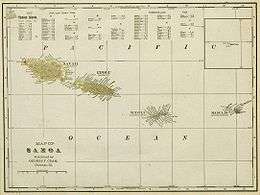
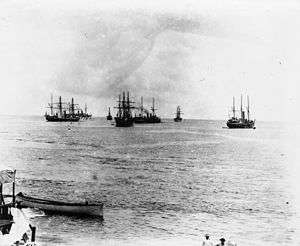
In March 1889, an Imperial German naval force entered a village on Samoa, and in doing so destroyed some American property. Three American warships then entered the Apia harbor and prepared to engage the three German warships found there.[12] Before any shots were fired, a typhoon wrecked both the American and German ships. A compulsory armistice was then called because of the lack of any warships.[12]
20th century
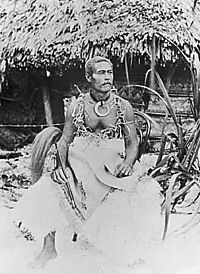
Early 20th century
At the turn of the twentieth century, international rivalries in the latter half of the century were settled by the 1899 Tripartite Convention in which Germany and the United States partitioned the Samoan Islands into two:[13] the eastern island group became a territory of the United States (the Tutuila Islands in 1900 and officially Manu'a in 1904)[14] and is today known as American Samoa; the western islands, by far the greater landmass, became known as German Samoa, after Britain gave up all claims to Samoa and in return accepted the termination of German rights in Tonga and certain areas in the Solomon Islands and West Africa.[15] Forerunners to the Tripartite Convention of 1899 were the Washington Conference of 1887, the Treaty of Berlin of 1889 and the Anglo-German Agreement on Samoa of 1899.
American colonization
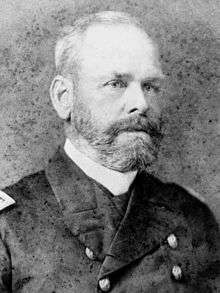
The following year, the U.S. formally annexed its portion, a smaller group of eastern islands, one of which contains the noted harbor of Pago Pago.[16] After the United States Navy took possession of eastern Samoa for the United States government, the existing coaling station at Pago Pago Bay was expanded into a full naval station, known as United States Naval Station Tutuila and commanded by a commandant. The Navy secured a Deed of Cession of Tutuila in 1900 and a Deed of Cession of Manuʻa in 1904 on behalf of the U.S. government. The last sovereign of Manuʻa, the Tui Manuʻa Elisala, signed a Deed of Cession of Manuʻa following a series of U.S. naval trials, known as the "Trial of the Ipu", in Pago Pago, Taʻu, and aboard a Pacific Squadron gunboat.[17] The territory became known as the U.S. Naval Station Tutuila.
On July 17, 1911, the U.S. Naval Station Tutuila, which was composed of Tutuila, Aunu'u and Manu'a, was officially renamed American Samoa.[18][19] People of Manu'a had been unhappy since they were left out of the name "Naval Station Tutuila". In May 1911, Governor William Michael Crose authored a letter to the Secretary of the Navy conveying the sentiments of Manu'a. The department responded that the people should choose a name for their new territory. The traditional leaders chose “American Samoa”, and, on July 7, 1911, the solicitor general of the Navy authorized the governor to proclaim it as the name for the new territory.[20]:209
World War I and the 1918 flu pandemic
In 1918, during the final stages of World War I, the flu pandemic had taken its toll, spreading rapidly from country to country. American Samoa became one of the only places in the world (the others being New Caledonia and Marajó island in Brazil) to have proactively prevented any deaths during the pandemic through the quick response from Governor John Martin Poyer after hearing news reports of the outbreak on the radio and requesting quarantine ships from the U.S. mainland. The result of Poyer's quick actions earned him the Navy Cross from the U.S. Navy. With this distinction, American Samoans regarded Poyer as their hero for what he had done to prevent the deadly disease. The neighboring New Zealand territory at the time, Western Samoa, suffered the most of all Pacific islands, with 90% of the population infected; 30% of adult men, 22% of adult women and 10% of children died. Poyer offered assistance to help his New Zealand counterparts, but was refused by the administrator of Western Samoa, Robert Logan, who became outraged after witnessing the number of quarantine ships surrounding American Samoa. Angered by this, Logan cut off communications with his American counterparts.
Interwar period
American Samoa Mau movement
After World War I, during the time of the Mau movement in Western Samoa (then a League of Nations mandate governed by New Zealand), there was a corresponding American Samoa Mau movement led by Samuelu Ripley, a World War I veteran who was from Leone village, Tutuila. After meetings in the United States mainland, he was prevented from disembarking from the ship that brought him home to American Samoa and was not allowed to return because the American Samoa Mau movement was suppressed by the U.S. Navy. In 1930, the U.S. Congress sent a committee to investigate the status of American Samoa, led by Americans who had a part in the overthrow of the Kingdom of Hawaii.
Annexation of Swains Island
Swains Island, which had been included in the list of guano islands appertaining to the United States and bonded under the Guano Islands Act, was annexed in 1925 by Pub. Res. 68–75.[22]
Pan American and first trans-South Pacific flight
.jpg)
In 1938, the noted aviator Ed Musick and his crew died on the Pan American World Airways S-42 Samoan Clipper over Pago Pago, while on a survey flight to Auckland, New Zealand. Sometime after takeoff, the aircraft experienced trouble, and Musick turned it back toward Pago Pago. While the crew dumped fuel in preparation for an emergency landing, an explosion occurred that tore the aircraft apart.[23]
World War II and aftermath
During World War II, U.S. Marines stationed in Samoa outnumbered the local population and had a huge cultural influence. Young Samoan men from age 14 and above were combat trained by U.S. military personnel. Samoans served in various capacities during World War II, including as combatants, medical personnel, code personnel, and ship repairmen.
In 1949, Organic Act 4500, a U.S. Department of Interior–sponsored attempt to incorporate American Samoa, was introduced in Congress. It was ultimately defeated, primarily through the efforts of Samoan chiefs, led by Tuiasosopo Mariota.[24] The efforts of these chiefs led to the creation of a territorial legislature, the American Samoa Fono, which meets in the village of Fagatogo. In 1950 the Department of the Interior began to administer the American Samoa.[25]
1951–1999

By 1956, the U.S. Navy–appointed governor was replaced by Peter Tali Coleman, who was locally elected. Although technically considered "unorganized" since the U.S. Congress has not passed an Organic Act for the territory, American Samoa is self-governing under a constitution that became effective on July 1, 1967. The U.S. Territory of American Samoa is on the United Nations list of Non-Self-Governing Territories, a listing which is disputed by the territorial government officials, who do consider themselves to be self-governing.
American Samoa and Pago Pago International Airport had historic significance with the Apollo Program.[26] The astronaut crews of Apollo 10, 12, 13, 14, and 17 were retrieved a few hundred miles from Pago Pago and transported by helicopter to the airport prior to being flown to Honolulu on C-141 Starlifter military aircraft.[27]
While the two Samoas share language and ethnicity, their cultures have recently followed different paths, with American Samoans often emigrating to Hawaiʻi and the U.S. mainland, and adopting many U.S. customs, such as the playing of American football and baseball. Samoans have tended to emigrate instead to New Zealand, whose influence has made the sports of rugby and cricket more popular in the western Samoan islands. Travel writer Paul Theroux noted that there were marked differences between the societies in Samoa and American Samoa.
21st century
American Samoans have a high rate of service in the U.S. Armed Forces.[28] Because of economic hardship, military service has been seen as an opportunity in American Samoa and other U.S. Overseas territories.[29] This has meant that there has been a disproportionate number of casualties per population compared to other parts of the United States. As of March 23, 2009, ten American Samoans had died in Iraq, and two had died in Afghanistan.[30]
As of August 7, 2020, American Samoa remains the only inhabited U.S. territory without any confirmed cases of COVID-19.[31][32]
Notable events
Pre-20th century
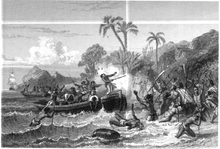
On December 10, 1787, French navigator Jean-François de Galaup, comte de Lapérouse landed two exploration parties on Tutuila's north shore: one from the ship La Boussole at Fagasa, and the other from L'Astrolabe at A'asu. One of the cooks, David, died of "scorbutic dropsy". On December 11, twelve members of Lapérouse's crew (including First Officer Paul Antoine Fleuriot de Langle) were killed by angry Samoans at A'asu Bay, Tutuila, thereafter known as "Massacre Bay", which Lapérouse described as "this den, more fearful from its treacherous situation and the cruelty of its inhabitants than the lair of a lion or a tiger". This incident gave Samoa a reputation for savagery that kept Europeans away until the arrival of the first Christian missionaries four decades later. On December 12, at A'asu Bay, Lapérouse ordered his gunners to fire one cannonball in the midst of the attackers who had killed his men the day before, and were now returning to launch another attack. He later wrote in his journal "I could have destroyed or sunk a hundred canoes, with more than 500 people in them: but I was afraid of striking the wrong victims; the call of my conscience saved their lives."[33][34]
In 1889, Robert Louis Stevenson paid a visit to Pago Pago.[35]
20th century

On December 15, 1916, English writer William Somerset Maugham arrived in Pago Pago, allegedly accompanied by a missionary and Miss Sadie Thompson. His visit inspired his short story "Rain" which later became plays and three major Motion Pictures. The building still stands where Maugham stayed and has been renamed the Sadie Thompson Building. Today it is a prominent restaurant and inn.[36]
On November 3, 1920, American Samoa's 12th naval governor, Commander Warren Jay Terhune, died by suicide with a pistol in the bathroom of the government mansion, overlooking the entrance to Pago Pago Harbor. His body was discovered by Government House's cook, SDI First Class Felisiano Debid Ahchica, USN. His ghost is rumored to walk about the grounds at night.[37]
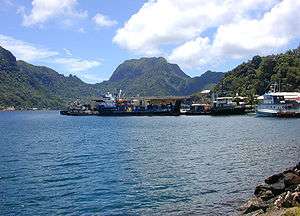
On August 11, 1925, Margaret Mead arrived in American Samoa aboard the SS Sonoma to begin fieldwork for her doctoral dissertation in anthropology at Columbia University, where she was a student of Professor Franz Boas. Her work Coming of Age in Samoa was published in 1928, at the time becoming the most widely read book in the field of anthropology. The book has sparked years of ongoing and intense debate and controversy. Mead returned to American Samoa in 1971 for the dedication of the Jean P. Haydon Museum.
On November 24, 1939, American Samoa's last execution was carried out. Imoa was convicted of stabbing Sema to death and was hanged in the Customs House. The popular Samoan song "Fa'afofoga Samoa" is based on this, said to be the final words of Imoa.[38]
On January 11, 1942, at 2:26 a.m., a Japanese submarine surfaced off Tutuila between Southworth Point and Fagasa Bay and fired about 15 shells from its 5.5-inch deck gun at the U.S. Naval Station Tutuila over the next 10 minutes. The first shell struck the rear of Frank Shimasaki's store, ironically owned by one of Tutuila's few Japanese residents. The store was closed, as Mr. Shimasaki had been interned as an enemy alien. The next shell caused slight damage to the naval dispensary, the third landed on the lawn behind the naval quarters known as "Centipede Row," and the fourth struck the stone seawall outside the customs house. The other rounds fell harmlessly into the harbor. As one writer described it, "The fire was not returned, notwithstanding the eagerness of the Samoan Marines to test their skill against the enemy ... No American or Samoan Marines were wounded."[39] Commander Edwin B. Robinson was bicycling behind Centipede Row and was wounded in the knee by a piece of shrapnel, and "a member of the colorful native Fita Fita Guard" received minor injuries; they were the only casualties. This was the only time the Japanese attacked Tutuila during World War II, although "Japanese submarines had patrolled the waters around Samoa before the war, and continued to be active there throughout the war."[39]
On August 24, 1943, First Lady Eleanor Roosevelt visited American Samoa and inspected the Fita Fita Guard and Band and the First Samoan Battalion of U.S. Marine Corps Reserve at the U.S. Naval Station American Samoa.[40]:178[41] The fact that First Lady reviewed the troops led to further assurance that Tutuila Island was considered safe.[42] Her presence underscored that World War II had passed by American Samoa. While the Fita Fita band played, Eleanor Roosevelt inspected the guard.[43]
On October 18, 1966, President Lyndon Baines Johnson and First Lady Lady Bird Johnson visited American Samoa. Mrs. Johnson dedicated the "Manulele Tausala" ("Lady Bird") Elementary School in Nu'uuli, which was named after her. Johnson is the only US President to have visited American Samoa, while Mrs. Johnson was the second First Lady, preceded by Eleanor Roosevelt in 1943.[40]:192 The territory's only hospital was renamed the LBJ Tropical Medical Center in honor of President Johnson.[44]
In the late 1960s and early 1970s, American Samoa played a pivotal role in five of the Apollo Program missions. The astronauts landed several hundred miles from Pago and were transported to the islands en route back to the mainland. President Richard Nixon gave three moon rocks to the American Samoan government, and these are on display in the Jean P. Haydon Museum, along with a flag carried to the moon on one of the missions.[45]
In November 1970, Pope Paul VI visited American Samoa in a brief but lavish greeting.[20]:292
On January 30, 1974, Pan Am Flight 806 from Auckland, New Zealand crashed at Pago Pago International Airport at 10:41 pm, with 91 passengers aboard. 86 people were killed, including Captain Leroy A. Petersen and the entire flight crew. Four of the five surviving passengers were seriously injured, with the other only slightly injured. The airliner was completely destroyed by the impact and succeeding fire. The crash was attributed to poor visibility, pilot error, or wind shear, since a violent storm was raging at the time.[46] In January 2014, filmmaker Paul Crompton visited the territory to interview local residents for a documentary film about the 1974 crash.
A U.S. Navy P-3 Orion patrol plane from Patrol Squadron 50 (VP-50) had its vertical stabilizer shorn off by the Solo Ridge-Mount Alava aerial tramway cable across Pago Pago harbor on April 17, 1980, during the Flag Day celebrations, when carrying six skydivers from the U.S. Army's Hawaii-based Tropic Lightning Parachute Club. The plane crashed, demolishing a wing of the Rainmaker Hotel and killing all six crew members and one civilian. The six skydivers had already left the aircraft during a demonstration jump. A memorial monument is erected on Mt. Mauga O Ali'i to honor their memory.
On November 1, 1988, President Ronald Reagan signed a bill which created American Samoa National Park.[47]
21st century
On July 22, 2010, Det. Lt. Lusila Brown was fatally shot outside the temporary High Court building in Fagatogo. It was the first time in more than 15 years that a police officer was killed in the line of duty. The last was Sa Fuimaono, who drowned after saving a teenager from rough seas.[48]
On November 8, 2010, United States Secretary of State and former First Lady Hillary Clinton made a refueling stopover at the Pago Pago International Airport. She was greeted by government dignitaries and presented with gifts and a traditional ava ceremony.[49]
Mike Pence was the third sitting U.S. Vice President to visit American Samoa (after Dan Quayle and Joe Biden)[50] when he made a stopover in Pago Pago in April 2017.[51] He addressed 200 soldiers here during his refueling stop.[52] U.S. Secretary of State Rex Tillerson visited town on June 3, 2017.[53]
September 2009 earthquake and tsunami
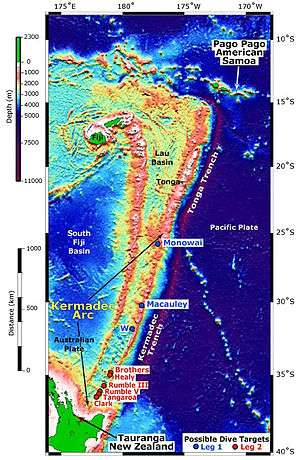
On September 29, 2009, at 17:48:11 UTC, an 8.1 magnitude earthquake struck 120 miles (190 km) off the coast of American Samoa, followed by smaller aftershocks.[54] It was the largest earthquake of 2009. The quake occurred on the outer rise of the Kermadec-Tonga Subduction Zone. This is part of the Pacific Ring of Fire, where tectonic plates in the Earth's lithosphere meet and earthquakes and volcanic activity are common. The quake struck 11.2 miles (18.0 km) below the ocean floor and generated an onsetting tsunami that killed more than 170 people in the Samoa Islands and Tonga.[55][56] Four waves with heights from 15 feet (4.6 m) to 20 feet (6.1 m) high were reported to have reached up to one mile (1.6 km) inland on the island of Tutuila.[57]
The Defense Logistics Agency worked with the Federal Emergency Management Agency to provide 16' × 16' humanitarian tents to the devastated areas of American Samoa.
Government and politics
Government
The government of American Samoa is defined under the Constitution of American Samoa as an unincorporated territory; the Ratification Act of 1929 vested all civil, judicial, and military powers in the President of the United States of America.[16] In 1951, with Executive Order 10264, President Harry Truman delegated that authority to the Secretary of the Interior. On June 21, 1963 Paramount Chief Tuli Le’iato of Faga’itua was sworn in and installed as the first Secretary of Samoan Affairs by Governor H. Rex Lee.[58] On June 2, 1967, Interior Secretary Fred Andrew Seaton promulgated the Constitution of American Samoa, which took effect on July 1, 1967.
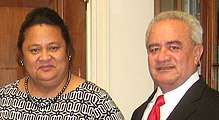
The Governor of American Samoa is the head of government and along with the Lieutenant Governor of American Samoa is elected on the same ticket by popular vote for four-year terms. Since American Samoa is a self-governing territory, the President of the United States serves as the Head of State. The President does not play an active role in government, but he can dissolve the Fono, and no act of parliament will become law without his approval.
The legislative power is vested in the American Samoa Fono, which has two chambers. The House of Representatives has 21 members, elected for a two-year term, 20 in single-seat constituencies and one by a public meeting on Swains Island. The Senate also has 18 members, elected for a four-year term by and from the chiefs of the islands.
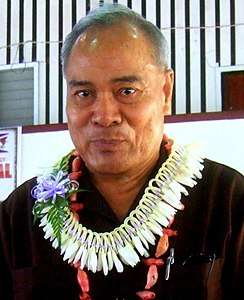
The judiciary of American Samoa is independent of the executive and the legislature, and the High Court of American Samoa is the highest court below the United States Supreme Court in American Samoa, with the District Courts below it. The High Court is located in the capital of Pago Pago. It consists of a Chief Justice and an Associate Justice, appointed by the United States Secretary of the Interior.
Politics
Politics of American Samoa takes place in a framework of a presidential representative democratic dependency, whereby the Governor is the head of government, and of a pluriform multi-party system. American Samoa is an unincorporated and unorganized territory of the United States, administered by the Office of Insular Affairs, U.S. Department of the Interior. In 1966, the United Nations gave American Samoa the option of joining the independent country of Samoa, but American Samoa chose to stay in the United States.[59] American Samoa's constitution was ratified in 1966 and came into effect in 1967. Executive power is exercised by the governor. Legislative power is vested in the two chambers of the legislature. The American political parties (Republican and Democratic) exist in American Samoa, but few politicians are aligned with the parties. The judiciary is independent of the executive and the legislature.
There is also the traditional village politics of the Samoa Islands, the "fa'amatai" and the "fa'asamoa", which continues in American Samoa and in independent Samoa, and which interacts across these current boundaries. The Fa'asamoa is the language and customs, and the Fa'amatai the protocols of the "fono" (council) and the chief system. The Fa'amatai and the Fono take place at all levels of the Samoan body politic, from the family, to the village, to the region, to national matters.
The 'aiga is the family unit of Samoan society, which differs from the Western sense of a family in that it consists of an 'extended family' based on the culture's communal socio-political organisation. The head of the 'aiga is the matai. The matai (chiefs) are elected by consensus within the fono of the extended family and village(s) concerned. The matai and the fono (which is itself made of matai) decide on distribution of family exchanges and tenancy of communal lands. The majority of lands in American Samoa and independent Samoa are communal. A matai can represent a small family group or a great extended family that reaches across islands, and to both American Samoa and independent Samoa.
In 2010, voters rejected a package of amendments to the territorial constitution, which would have, among other things, allowed U.S. citizens to be legislators only if they had Samoan ancestry.
In 2012, both the Governor and American Samoa's delegate to the U.S. Congress Eni Faleomavaega called for the populace to consider a move towards autonomy if not independence, to a mixed response.[60][61]
Nationality
According to the Immigration and Nationality Act (INA), the people born in American Samoa—including those born on Swains Island—are "nationals but not citizens of the United States at birth".[5][6][62][63] If a child is born on any of these islands to any U.S. citizen, then that child is considered a national and a citizen of the United States at birth.[64] In an amicus curiae brief filed in federal court, American Samoan Congressman Faleomavaega supported the legal interpretation that the Citizenship Clause of the Fourteenth Amendment does not extend birthright citizenship to United States nationals born in unincorporated territories.[65][66] All U.S. nationals have statutory rights to reside in all parts of the United States, and may apply for citizenship by naturalization after three months of residency by paying a fee, passing a test in English and civics, and taking an oath of allegiance to the United States.[67] However, the INA makes clear that any "national but not a citizen of the United States" who at any time has been convicted of any aggravated felony, whether the aggravated felony was committed inside or outside the United States, is "debarred from becoming a citizen of the United States".[68][69][70][71][72] All U.S. nationals also have the right to work in the United States, except in certain government jobs that specifically require U.S. citizenship.
American Samoans elect one non-voting delegate to the United States House of Representatives.[73] Their delegate from 1989 until 2015 was Democrat Eni Faleomavaega. In the 2014 Midterm Election, Republican Aumua Amata Radewagen defeated Eni Faleomavaega, becoming the first female and first Republican representative of American Samoa.[74] They also send delegates to the Democratic and Republican National Conventions. U.S. nationals residing in American Samoa, whether U.S. citizens or not, are eligible to vote in these federal elections, as well as elections for the territorial government.[75] However, those residing in other parts of the United States are not allowed to vote in federal, state or the vast majority of local elections unless they are U.S. citizens.
In December 2019, U.S. District Judge Clark Waddoups struck down as facially unconstitutional, holding that "Persons born in American Samoa are citizens of the United States by virtue of the Citizenship Clause of the Fourteenth Amendment",[76] but stayed his order pending appeal.[77] Therefore most American Samoans continue to be treated as U.S. nationals but not U.S. citizens.
Immigration law
Unique among U.S. territories, American Samoa has its own immigration law, separate from the laws that apply in other parts of the United States. While U.S. nationals can freely move to American Samoa, the American Samoan government, via the Immigration Board of American Samoa, controls the migration of aliens to the islands.[78][79] Special application forms exist for migration to American Samoa based on family or employment sponsorship.[80]
Unlike all other permanently inhabited U.S. jurisdictions (states, District of Columbia, Puerto Rico, U.S. Virgin Islands, Guam and Northern Mariana Islands), American Samoa is not considered a U.S. state for the purposes of the U.S. Immigration and Nationality Act. This means that alien lawful permanent residents of the United States may be considered to have abandoned permanent residence if they have moved to live in American Samoa, and time spent there does not count for naturalization.[81][82] While it is possible for aliens to obtain legal residency in American Samoa under its own laws, it is not possible for them to acquire U.S. citizenship, or U.S. nationality at all, by residing there.
U.S. nationals without U.S. citizenship (the status of most American Samoans) have the right to reside in all parts of the United States without immigration restrictions. They also have the same rights as lawful permanent residents to sponsor foreign family members to immigrate to the United States (they may sponsor spouses and unmarried children), but not the same rights as U.S. citizens (who may also sponsor parents, married children and siblings).[83]
Land ownership
About 90 percent of the land is communally owned by 'aiga.[14][20]:212 It is illegal for any person whose blood is less than one-half Samoan to own land in American Samoa.[84]
Official protest to naming of neighboring Samoa
The U.S. Embassy in Samoa notes that: "In July 1997 the Constitution was amended to change the country's name from Western Samoa to Samoa. Samoa had been known simply as Samoa in the United Nations since joining the organization in 1976. The neighboring U.S. territory of American Samoa protested the move, feeling that the change diminished its own Samoan identity. American Samoans still use the terms Western Samoa and Western Samoans."[85]
Administrative divisions
American Samoa is administratively divided into three districts—Eastern District, Western District, and Manu'a District—and two "unorganized" atolls, Swains Island and the uninhabited Rose Atoll. The districts and unorganized atolls are subdivided into 74 villages. Pago Pago—the capital of American Samoa[3]—is one of the largest villages and is located on the eastern side of Tutuila island in Ma'oputasi County. Fagatogo is listed in the Constitution of American Samoa as the official seat of government, but it is not the capital.[86][87][88]
Geography

American Samoa, located within the geographical region of Oceania, is one of only two possessions of the United States in the Southern Hemisphere, the other being Jarvis Island. Its total land area is 76.1 square miles (197.1 km2)—slightly larger than Washington, D.C.—consisting of five rugged, volcanic islands and two coral atolls.[89] The five volcanic islands are Tutuila, Aunu'u, Ofu, Olosega, and Ta‘ū. The coral atolls are Swains and Rose Atoll. Of the seven islands, Rose Atoll is the only uninhabited one; it is a Marine National Monument. American Samoa is the southernmost reach of the United States at fourteen degrees below the equator.[90]

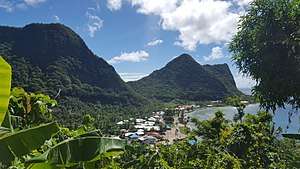
Due to its positioning in the South Pacific Ocean, it is frequently hit by tropical cyclones between November and April. Rose Atoll is the easternmost point of the territory. American Samoa's Rose Atoll is the southernmost point of the United States.[91] American Samoa is home to the National Park of American Samoa.
The highest mountains are: Lata Mountain (Ta‘ū), 3,170 ft (970 m); Matafao Peak, 2,141 ft (653 m); Piumafua (Olosega), 2,095 ft (639 m); and Tumutumu (Ofu), 1,621 ft (494 m). Mount Pioa, nicknamed the Rainmaker, is 1,718 ft (524 m).[20]:3 American Samoa is also home to some of the world's highest sea cliffs at 3,000 ft (910 m).[92]
The Vailulu'u Seamount, an active submerged volcano, lies 28 miles (45 km) east of Ta‘ū in American Samoa. It was discovered in 1975 and has since been studied by an international team of scientists, contributing towards understanding of the Earth's fundamental processes.[93] Growing inside the summit crater of Va'ilulu'u is an active underwater volcanic cone, named after Samoa's goddess of war, Nafanua.
Climate
American Samoa has a tropical climate all year round with two distinct seasons, the wet and dry season. The wet season is usually between December and March and the dry season from April through to September with the average daily temperature around 81–83 °F (27–28 °C) all year round.
The climate is warm, tropical, and humid, averaging around 80 °F or 26.7 °C, with a variation of about 15 °F or 8 °C during the year. The southern hemisphere winter, from June to September, is the coolest time of the year. The summer months of December to March bring hotter temperatures, while the months from April to November are considered the “dry” season. Throughout the year, however, rain follows clouds blown in by the trade winds that rise from the east almost daily. The mountains of the Pago Pago area, standing protectively over Pago Pago Harbor, catch these clouds, bringing an average of 200 inches or 5,100 millimetres of rainfall per year.[20]:4
Climate change

Climate change in American Samoa encompasses the effects of climate change, attributed to man-made increases in atmospheric carbon dioxide, in the U.S. territory of American Samoa.
The American Samoa Environmental Protection Agency (ASEPA) notes that the territory "has a fragile ecosystem" which is "directly and immediately impacted by global climate change".[94] Due to the shoreline concentration of the population, rising sea levels are likely to destroy property and displace residents.[94] "This increase in sea level means that anything that makes the ocean waves reach farther inland (such as a king tide or a tropical cyclone) will cause more flooding than when the sea level was lower. For example, a deadly tsunami struck American Samoa in 2009, and because of longterm sea level rise over the past century, it caused more damage than it would have if sea level had not been rising".[95] Freshwater aquifers from which the local water supply is drawn are similarly threatened with seawater intrusion due to rising sea levels.[94]
It has further been noted that climate change "warms nearshore waters causing the corals to bleach and/or die", with warm-water bleaching occurring annually by the mid-2010s, and with "significant bleaching events [having] occurred in 1994, 2002 and 2003".[96] ASEPA similarly notes that "[c]limate change endangers the survival of our coral reefs", which help protect the island from hurricanes and support local fishing.[94]
Scientists predict a possible increase in mosquito-borne diseases such as dengue fever in tropical regions including American Samoa due to global warming, which "appears to be triggering a number of disease epidemics worldwide, involving a diversity of pathogens (viruses, bacteria, fungi, parasites) and a wide range of hosts".[96]Economy
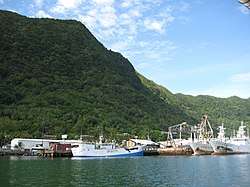

The economic health of American Samoa reflects the trends in other populated U.S. territories, which are in turn dependent on federal appropriations. Federal dollars enter the economy through congressional appropriations, categorical grants, Social Security payments, and payments to Samoans retired from the Military. Tuna canning is the backbone of the American Samoa economy. Cannery employment and local auxiliary businesses provide additional revenues for the territorial government. In the mid-1960s, efforts began to develop a tourism industry in American Samoa. These efforts have been delayed due to issues such as inconsistent airlines services, insufficient high-quality accommodations, and the lack of well-trained workers in the hospitality and tourism industries. Agriculture and fishing still provide sustenance for local families.[20]:8–9
Employment on the island falls into three relatively equal-sized categories of approximately 5,000 workers each: the public sector, the single remaining tuna cannery, and the rest of the private sector.
There are only a few federal employees in American Samoa and a few active duty military personnel, except members of the U.S. Coast Guard, military recruiters, and some Full Time Support staff at the Pele Army Reserve unit that maintains the facility and provides cadre, training, and logistics support. The Pele US Army Reserve Center is in Tafuna, Western District,[97] and a U.S. Army and United States Marine Corps recruiting station is in Nu'uuli, American Samoa.
There are six Army Reserve units at Pele:[98]
- Bravo Company, 100th Battalion, 442 Infantry;
- Charlie Company, 100th Battalion, 442nd Infantry;
- 411th Forward Support Company (Engineer);
- USAR Theater Support Group Detachment American Samoa;
- 1st Evacuation/Mortuary Platoon, 2nd Platoon, 962nd Quartermaster Company; and
- 127th Chaplain Detachment.
The overwhelming majority of public sector employees work for the American Samoa territorial government. The one tuna cannery is StarKist, which exports several hundred million dollars worth of canned tuna to the United States each year. The other tuna cannery was Samoa Packing, a Chicken of the Sea subsidiary, but it closed in 2009 due to American Samoans being granted minimum wage.[99] In early 2007, the Samoan economy was highlighted in the Congress at the request of Eni Faleomavaega, the Samoan delegate to the United States House of Representatives, as it was not mentioned in the minimum wage bill.
From 2002 to 2007, real GDP of American Samoa increased at an average annual rate of 0.4 percent. The annual growth rates of real GDP ranged from −2.9 percent to +2.1 percent. The volatility in the growth rates of real GDP was primarily accounted for by changes in the exports of canned tuna. The tuna canning industry was the largest private employer in American Samoa during this period. In 2017, GDP in American Samoa decreased by 5.8%, but in 2018 it increased by 2.2%.[100]
| 2002 | 2003 | 2004 | 2005 | 2006 | 2007 | 2002–2007 AAGRA | |
|---|---|---|---|---|---|---|---|
| GDPB | 536 | 527 | 553 | 550 | 548 | 532 | −0.1% |
| Real GDPC | 527 | 535 | 539 | 550 | 534 | 537 | 0.4% |
| PopulationD | 60,800 | 62,600 | 64,100 | 65,500 | 66,900 | 68,200 | 2.3% |
| Real GDP per capita | 8,668 | 8,546 | 8,409 | 8,397 | 7,982 | 7,874 | −1.9% |
- A Average annual growth rate.
- B In millions of dollars.
- C In millions of 2005 chained dollars.
- D Source: 2008 American Samoa Statistical Yearbook.
From 2002 to 2007, the population of American Samoa increased at an average annual rate of 2.3 percent, and real GDP per capita decreased at an average annual rate of 1.9 percent.
Agricultural production serves as a cover for domestic needs and only a small share of fruits and vegetables are exported. According to figures as of 2013, the ratio between import and export is almost balanced. Many residents rely on transfer payments from relatives living in the mainland or from federal subsidies.[101]
The Fair Labor Standards Act of 1938 has contained special provisions for American Samoa since its inception, citing its limited economy.[102] American Samoan wages are based on the recommendations of a Special Industry Committee meeting bi-annually.[103] Originally, the act contained provisions for other territories, provisions which were phased out as those territories developed more diverse economies.[104]
In 2007, the Fair Minimum Wage Act of 2007 was passed, increasing minimum wage in American Samoa by 50¢ per hour in 2007 and another 50¢ per hour each year thereafter until the minimum wage in American Samoa equals the federal minimum wage of $7.25 per hour in the United States.[105] In response to the minimum wage increase, the Chicken of the Sea tuna canning plant was shut down in 2009 and 2,041 employees were laid off in the process.[106] The other major tuna canning plant in American Samoa is StarKist, which began laying off workers in August 2010, with plans to lay off a total of 800 workers due to the minimum wage increases and other rising operation costs.[107] American Samoa Governor Togiola Tulafono suggested that, rather than laying off minimum wage workers, the companies could reduce salaries and bonuses of top-tier employees.[108]
The unemployment rate was 29.8% in 2005, but has been improved to 23.8% as of 2010. In 2017, American Samoa's GDP was $634 million.[109] Its GDP per capita (PPP) was $11,200 as of 2016.[3]
Some aspects of telecommunications in American Samoa are, like other U.S. territories, inferior to that of the mainland United States; a recent estimate showed that American Samoa's Internet speed is slower than that of several Eastern European countries.[110]
Taxation
As in other U.S. territories, the U.S. federal government imposes payroll taxes[111][112] and the equivalent self-employment tax[113] on income from work in American Samoa, but not the federal income tax on income generated in American Samoa by its residents (except from work as U.S. government employees).[114] Instead, the government of American Samoa itself taxes the worldwide income of its residents, as well as the income generated there by nonresidents, largely under the same rules and rates as the U.S. tax code in effect in 2000,[115][116] with certain modifications such as a minimum tax rate of 4%[117] and an additional wage tax of 2%.[118][119] A similar situation applies to corporations.[120] In 1983, the use of citizenship in taxation by American Samoa (due to its incorporation of the U.S. tax code) was ruled unconstitutional.[121]
The U.S. federal government does not impose estate or gift taxes on property not located in the United States (states and District of Columbia) owned by residents of a U.S. territory (including American Samoa) who are not U.S. citizens or who acquired U.S. citizenship by birth or naturalization in that same U.S. territory.[122] However, these taxes still apply to residents of a U.S. territory who acquired U.S. citizenship by birth or naturalization in a different part of the U.S. or by descent.[123] It has been argued that this distinction based on place of birth, and not only residence or citizenship, is a rare case of unconstitutional tax discrimination, but it has never been challenged in court.[124] The government of American Samoa itself does not impose estate or gift taxes.[125]
Unlike U.S. citizens, U.S. nationals without U.S. citizenship (the status of most American Samoans) who do not reside in the United States or any U.S. territory enjoy the unique combination of maintaining a U.S. passport and the right of return to the U.S. while not being subject to U.S. federal income tax on their non-U.S. income,[126] or to U.S. federal estate or gift taxes on their non-U.S. property.[127][128] It is not possible for U.S. citizens (or anyone) to acquire this status after birth.[129][130]
American Samoa does not impose a sales tax, but it imposes a general import tax of 8%.[131][132][133] American Samoa is an independent customs territory, whose importation rules and taxes differ from those applicable to other parts of the United States.[134][135]
Telecommunications
In 2012 Michael Calabrese, Daniel Calarco, and Colin Richardson stated that American Samoa had the most expensive internet of any U.S. territory, and that the speeds were only slightly superior to those of dial-up internet in the U.S. Mainland in the 1990s. They also stated that many American Samoans are too poor to afford "high-speed internet".[136]
Transportation

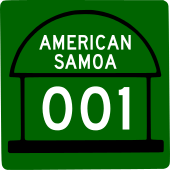
American Samoa has 241 km of highways (estimated in 2008).[3] The maximum speed limit is 30 miles per hour.[137] Ports and harbors include Aunu‘u, Auasi, Faleāsao, Ofu and Pago Pago.[3] American Samoa has no railways.[3] The territory has three airports, all of which have paved runways. The main airport is Pago Pago International Airport,[3] on the island of Tutuila. The Manu'a group has two airports: Ofu Airport on the island of Ofu, and Fitiuta Airport on the island of Ta'u. According to a 1999 estimate, the territory has no merchant marine.[3]
On June 8, 1922, the first bus service on Tutuila began its operations.[138] There is currently a bus system in American Samoa called the aiga bus system—it consists of buses that travel across the island of Tutuila.[139][140]
Demographics
As of 2020 the population of American Samoa is about 55,212 people,[1][5][6][2] 97% of whom live on the largest island, Tutuila.[141] About 65% of the population are U.S. nationals, of whom at least 10% are U.S. citizens.[7] Of the foreign-born population, 81% are from Samoa, 9% are from other parts of Oceania, and 9% are from Asia.[7]
American Samoa is small enough to have just one ZIP code, 96799, and uses the U.S. Postal Service (state code "AS") for mail delivery.[142][143]
Ethnicity and language
Of the population, 88.9% are native Samoans, 3.7% are other Pacific Islanders, 3.6% are Asian, 2.7% are mixed, and 1.2% are of other origins. Samoan, a language closely related to Hawaiian and other Polynesian languages, is spoken natively by 88.6% of the people and is the co-official language of the territory, while 3.9% speak only English, 2.7% speak Tongan, 3% speak other Pacific islander languages, and 1.8% speak other languages.[3][7] Most people are bilingual,[3] and only 1.2% do not speak English.[7] At least some of the deaf population use Samoan Sign Language. Tokelauan is also spoken in Swains Island.
Religion
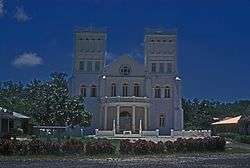
Major Christian denominations on the island include the Congregational Christian Church in American Samoa, the Catholic Church, The Church of Jesus Christ of Latter-day Saints and the Methodist Church of Samoa. Collectively, these churches account for the vast majority of the population.
J. Gordon Melton in his book claims that the Methodists, Congregationalists with the London Missionary Society, and Roman Catholics led the first Christian missions to the islands. Other denominations arrived later, beginning in 1895 with the Seventh-day Adventists, various Pentecostals (including the Assemblies of God), Church of the Nazarene, Jehovah's Witnesses and The Church of Jesus Christ of Latter-day Saints.
CIA Factbook 2010 estimate shows the religious affiliations of American Samoa as 98.3% Christian, other 1%, unaffiliated 0.7%.[3] World Christian Database 2010 estimate shows the religious affiliations of American Samoa as 98.3% Christian, 0.7% agnostic, 0.4% Chinese Universalist, 0.3% Buddhist and 0.3% Bahá'í.[144]
According to Pew Research Center, 98.3% of the total population is Christian. Among Christians, 59.5% are Protestant, 19.7% are Roman Catholic and 19.2% are other Christians. A major Protestant church on the island, gathering a substantial part of the local Protestant population, is the Congregational Christian Church in American Samoa, a Reformed denomination in the Congregationalist tradition. As of August 2017, The Church of Jesus Christ of Latter-day Saints website claims membership of 16,180 or one-quarter of the whole population, with 41 congregations, and 4 family history centers in American Samoa.[145] Jehovah's Witnesses claim 210 "ministers of the word" and 3 congregations.[146]
Education
The island contains 23 primary schools and 10 secondary schools, 5 are operated by the American Samoa Department of Education,[147] and the other 5 are administered by either religious denominations or are privately owned. American Samoa Community College, founded in 1970, provides post-secondary education on the islands.
American Samoa was home to one high school as of 1961, which existed due to the matai's pressure on the naval governor to transform the old Marine barracks at Utulei into a school. The teenagers of well-off and more politically connected families attended the school, which would later be known as Samoana High School. With a median age of 15, the demand for more high schools was increasing, and three new high schools were established by 1968. Another two soon followed, and by 1979, 2,800 high school students were attending six public and private high schools in American Samoa. Looking for a cost-effective way for educational reformation, Governor H. Rex Lee introduced the public television system in 1964.[148]
Culture
The Samoan culture has developed over 3,500 years and largely withstood interaction with European cultures. It was adapted well to the teachings of Christianity. The Samoan language is still in use in daily exchange; however, English is widely used and also the legal official language. Besides Samoan language classes and cultural courses, all instructions in public schools are in English. The basic unit of the American Samoa culture is the aiga (family). It consists of both immediate and extended family. The matai, or chief, is the head of the aiga. The chief is the custodian of all aiga properties. A village (nu'u) is made up of several or many aiga with a common or shared interest. Each aiga is represented by their chief in the village councils.[20]:5–6
Music
Music in Somoa is a complex mix of cultures and traditions, with pre- and post-European contact histories. Since American colonization, popular traditions such as rap and hip hop have been integrated into Somoan music.
Traditional Samoan musical instruments includes several different distinctive instruments, including a fala, which is a rolled-up mat beaten with sticks and several types of slit drum.Sports

The main sports played in American Samoa are football, Samoan cricket, canoeing, yachting, basketball, golf, netball, tennis, rugby, table tennis, boxing, bowling, volleyball, and fishing tournaments. Some current and former sports clubs are the American Samoa Tennis Association, Rugby Unions, Lavalava Golf Club, and Gamefish Association. Leagues improved and organized better after the completion of the Veterans Memorial Stadium.[20]:338
The 1997 South Pacific Mini Games were the biggest international event ever to take place in American Samoa. The bid to host the games for the 23 participating countries was approved in May 1993. In January 1994, Governor A. P. Lutali appointed Fuga Teleso to head the task force charged with game preparations, including the construction of a stadium. Groundbreaking was in January 1994. The Governor later handed the task force on preparations to Lieutenant Governor Togiola. The task force merged with the American Samoa National Olympics Committee to better coordinate and facilitate preparations. V.P. Willis Construction built the 1,500 seat stands. The Department of Public Safety trained its force for special games security. The opening ceremony became extravagant where the U.S. Army Reserve carried the torch from Tula and Leone.[20]:357–358
About 2,000 athletes, coaches, and sponsors attended from 19 countries and competed in 11 sports at the game. American Samoa fielded a team of 248 athletes. The team won 48 medals, 22 of which were gold medals, and American Samoa came in fourth overall in the ratings. American Samoa Rotary Club honored Fuga Tolani Teleso with the community's top award, the Paul Harris Fellowship Award, for his work on constructing the Veterans Memorial Stadium.[20]:359
In 1982, yachters competed in the Hobie World Championship held in Tahiti. American Samoa beat the Apia team by half a point and won the Samoa Cup. In 1983, a team coached by Dr. Adele Satele-Galeai brought home the winning trophy from the Regional Women's Volleyball Tournament in Hawai'i. Also in 1983, the South Pacific Games were held in Apia. American Samoa received 13 medals: four gold, four silver, and five bronze. That same year, three junior golfers made the cut out of 1,000 players to attend the World Junior Golf Tournament in San Diego, California.[20]:338
In 1987, American Samoa became the 167th member of the International Olympic Committee. The first South Pacific Junior Tennis Tournament was held at the Tafuna courts in January 1990.[20]:339
Tony Solaita was the first American Samoan to play in Major League Baseball.[20]:339 There are thirty players from American Samoa in the National Football League (NFL) as of 2015, and over 200 play Div. I NCAA Football.[149] Some American Samoan NFL football players are Shalom Luani, Junior Siavii, Jonathan Fanene, Mosi Tatupu, Shaun Nua, Isaac Sopoaga, and Daniel Te'o-Nesheim.
After World War II, a Welfare and Recreation Department was created. This department arranged bowling, softball, badminton tournaments, basketball, and volleyball at various Tutuila locations. Boxing matches and dancing also became popular activities.[150]
American football
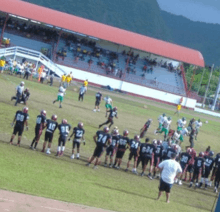
About 30 ethnic Samoans, all from American Samoa, currently play in the National Football League, and more than 200 play NCAA Division I college football.[151] In recent years, it has been estimated that a Samoan male (either an American Samoan, or a Samoan living in the mainland United States) is anywhere from 40[152] to 56 times[151] more likely to play in the NFL than a non-Samoan American, giving American Samoa the nickname "Football Islands".[59] Samoans are the most disproportionately overrepresented ethnic group in the National Football League.[153][154]
Six-time All-Pro Junior Seau was one of the most famous Americans of Samoan heritage ever to play in the NFL, having been elected to the NFL 1990s All-Decade Team and Pro Football Hall of Fame. Pittsburgh Steelers safety Troy Polamalu, though born and raised in the mainland United States, is another famous American of Samoan heritage to have played in the NFL, not having his hair cut since 2000 (and only because a USC coach told him he had to) and wearing it down during games in honor of his heritage. The football culture was featured on 60 Minutes on January 17, 2010.
At the 2016 Republican National Convention, American Samoa's delegation said American Samoa is "the greatest exporter of NFL players".[155][156]
Soccer
The American Samoa national association football team is one of the newest teams in the world, and is also noted for being the world's weakest. They lost to Australia 31–0 in a FIFA World Cup qualifying match on April 11, 2001, but on November 22, 2011, they finally won their first ever game, beating Tonga 2–1 in a FIFA World Cup qualifier.[157] The appearance of American Samoa's Jaiyah Saelua in the contest "apparently became the first transgender player to compete on a World Cup stage".[158]
The American Samoan national team features in the highly-rated 2014 British film Next Goal Wins.[159] The film documents the team's 2014 FIFA World Cup qualifying campaign, in which they achieved their first-ever international win.[160] Saelua and Nicky Salapu, the man famous for being the goalkeeper during the team's 31-0 loss to Australia in 2001, feature prominently in the film.[159] A feature film adaptation of the documentary is planned, which will be directed by Taika Waititi.[161]
Rugby league
The American Samoa national rugby league team represents the country in international rugby league. The team competed in the 1988, 1992, 1998 and 2004 Pacific Cup competitions. The team has also competed in the 2003 and 2004 World Sevens qualifiers in the 2005 World Sevens. America Samoa's first match in international Rugby League was in 1988 pacific cup against Tonga, Tonga won the match 38–14 which is still the biggest loss by an American Samoan side. American Samoa's biggest win was in 2004 against New Caledonia with the score ending at 62–6.
American Samoa gets broadcasts of the National Rugby League in Australia on free-to-air television.[162]
There is also a new movement which aims to set up a four-team domestic competition in American Samoa.[162]
Rugby union
Rugby union is a growing sport in American Samoa. The first rugby game recorded in American Samoa was in 1924, since then the development of the game had been heavily overshadowed by the influence of American Football during the 1970s. The highest governing body of rugby in American Samoa is the American Samoa Rugby Union which was founded in 1990 and was not affiliated into the IRB until 2012. Internationally, two American Samoans have played for the New Zealand national rugby union team, known as the All Blacks. Frank Solomon (born in Pago Pago) became the first American national of Samoan descent to play for a New Zealand team. Considered a pacific pioneer in New Zealand rugby, Solomon scored a try against Australia in the inaugural Bledisloe Cup match in 1932, which New Zealand won 21–13.
The second American Samoan to play for the All Blacks is Jerome Kaino (born in Faga'alu). A native of Leone, Kaino moved to New Zealand when he was 4 years old. In 2004, at age 21, he played his first match for New Zealand against the Barbarians where he scored his first try, contributing to New Zealand's 47–19 victory that resulted in him becoming man of the match. He also played a crucial role in the Rugby World Cup 2011 playing every match in the tournament. He scored four tries in the event which led to New Zealand winning the final against France 8–7. Kaino was also a key member of the 2015 Rugby World Cup squad, where he played every match including a try he scored in the quarterfinals against France which New Zealand won 62–13. He scored again in the semifinals against South Africa, which New Zealand won 20–18. He played in the World Cup final against Australia where New Zealand won again 34–17 to become world champions for a record 3 times (1987, 2011 and 2015). Kaino is one of twenty New Zealand rugby players to have won the Rugby World Cup twice, back to back in 2011 and 2015. In August 2015, the American Samoa Rugby Union Board selected Leota Toma Patu from the village of Leone as the coach for the Talavalu 15 men's team that represented American Samoa at the Ocean Cup 2015 in Papua New Guinea.
Other sports
- Boxing: Maselino Masoe, who represented American Samoa in three consecutive Olympics from 1988 to 1996, was WBA middleweight champion from 2004 to 2006.
- Professional wrestling: A number of American Samoan athletes have been very visible in professional wrestling. The Anoa'i family in particular has had many of its members employed by WWE.
- Sumo wrestling: Some Samoan Sumo wrestlers, most famously Musashimaru and Konishiki, have reached the highest ranks of ōzeki and yokozuna.
- Track and field: Hammer thrower Lisa Misipeka attracted international attention by winning a bronze medal in the 1999 World Championships in Athletics.
Recreation

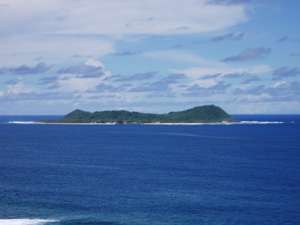
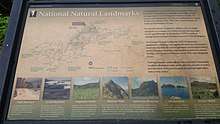
A team from the Bureau of Outdoor Recreation conducted a parks survey on American Samoa in the 1960s. Their team recommended sites at Cape Taputapu, Le'ala at Vailoatai, A'oloau Fou (the plateau), Matautuloa Point, Nu'uuli, Matafao Peak, Pago Pago, Vai'ava Strait, Anasosopo, 'Aoa, Cape Matautuloa, and Aunu'u Island. After an initial objection, Secretary Le'iato gave his support and was appointed Chairman of the Territorial Parks and Recreation Committee. The first field meeting for a parkland acquisition was held between Judge Morrow on behalf of the government and the village council of Vatia to make the Pola Island area a public park. The dredge Palolo was hired from Upolu in January 1966 in order to dredge sand for Utulei Beach. A specialist in beach developments, Ala Varone of the Army, directed the project. The centerpiece of the park was to be at the head of Pago Pago Harbor, where it proposed a 13-acre site created by the dredge. The park would have facilities for sports and recreation as well as facilities for boats and the growing number of Asian immigrants arriving from Korea, Japan and China.[20]:285
The Department of Parks and Recreation was created by law in 1980 and the Parks Commission was also established.[20]:315 In 1981, Governor Peter Tali Coleman appointed Fuga Tolani Teleso as Director of Parks and Recreation. On May 25, 1984, a groundbreaking ceremony was held at the Onesosopo reclamation to initiate work on the first park in the Eastern District.[20]:332
At the urging of Dr. Paul Cox, High Chief Nafanua of Falealupo, and the Bat Preservers Association, Congressman Fofó Iosefa Fiti Sunia introduced a bill in 1984 which would enter American Samoa into the Federal Fish and Wildlife Restoration Act. The purpose of the bill was to protect the ancient paleotropical rainforests and the Flying fox megabat. The signing marked the beginning of American Samoa's entry into the U.S. National Park System. In July 1987, the National Park Service began establishing a federal park. An initial appropriation of $400,000 was made in 1989. It contains one of the world's most remarkable rain forest and coastal reef ecologies and spreads across three islands. One of the most popular sites on Tutuila Island include Pola Rock, a rise of sheer rock formations that protrudes over 400 ft above the ocean's surface. It is located off the shores of Vatia.[20]:332 On September 19, 1991, Governor Peter Tali Coleman and Department of the Interior secretary Manuel Lujan signed leases formalizing the establishment of the fiftieth U.S. National Park.[20]:335
The ASG Parks and Recreation oversees the maintenance of all public parks, including the Amanave Mini Park, Lions Park in Tafuna, Onesosopo Park in Aua, Malaloa Mini Park, Faga'alu Park, Tia Seu Lupe historical site at Fatuoaiga, Pago Pago Park, Pago Pago Tennis Courts, the Little League Softball Field, Tony Sola'ita Baseball Field, Solo Ridge at the Utulei Tramway, Utulei Beach Park and Su’igaulaoleatuvasa in Utulei.[163]
American Samoa has seven areas designated as National Natural Landmarks on Tutuila Island. This program is administrated by the U.S. National Park Service and the areas contain unique ecological or geological features. With the exception of Vai'ava Strait, none of the areas are within the National Park of American Samoa.[164]:281 American Samoa's seven National Natural Landmarks (NNL) were designated in 1972:
Wildlife
Notable terrestrial species include the Pacific boa and the Flying Megabat, which has a three-foot wingspread.[165] Two snake species can be found in American Samoa: The Australoasian blindsnake is found on Tutuila, while the Pacific boa occurs on Ta'ū. The islands are home to five species of geckos: Pacific slender-toed gecko, Oceanic gecko, Mourning gecko, Stump-toed gecko, and House gecko.[166][164]:253
Turtles include the threatened Green sea turtle and the endangered Hawksbill sea turtle. Hawksbill sea turtles tend to nest on Tutuila beaches, while the Green sea turtle is most common on Rose Atoll.[167] Tutuila has the highest number of nesting turtles, consisting of around fifty nesting females per year.[168]
American Samoa is home to one species of amphibian: the Cane toad. Biologists estimate that there are over two million toads on Tutuila.[164]:252
915 nearshore fish species have been recorded in American Samoa, compared to only 460 nearshore fish species in Hawai'i.[164]:20 With over 950 species of native fish and 250 coral species, American Samoa has the greatest marine biodiversity in the United States.[169]
Fruit bats

Megabats are the only native mammal in American Samoa. The islands are home to two species of fruit bats: Pacific Flying Fox and Samoa flying fox. The Sheath-tailed bat is another species found here, which is a smaller insect-eating bat. In 1992, the American Samoa Government banned the hunting of fruit bats to help their populations recover.[170] The Samoa flying fox is only found in Fiji and the Samoan Islands.[171][164]:200
From 1995–2000, the population of Samoa flying fox remained stable at about 900 animals on Tutuila, and 100 in the Manu'a Islands.[172] As of the year 2000, scientists from the American Samoa Department of Marine and Wildlife Resource estimated that there are fewer than 5,500 Pacific flying foxes in American Samoa, and an estimated 900 or fewer Samoa flying foxes.[164]:199 The best and biggest known roost on Tutuila Island for the Sheath-tailed bat is in the Anape'ape Cove near Āfono.[173]
Amalau Valley on Tutuila's north coast offers great roadside views of many bird species and both species of Flying fox fruit bat.[164]:274 The valley has been called a prime bird- and bat-watching area.[174][175][176]
Avifauna
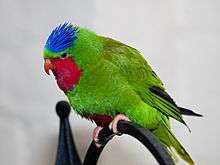
Sixteen of the Samoan Islands’ 34 bird species are found nowhere else on Earth. This includes the critically endangered Tooth-billed pigeon.[177] Four species of birds are only found in the Manu'a Islands and not on Tutuila. These include American Samoa's only parrot, the Blue-crowned Lory. Other special birds to Manu’a are the Lesser shrikebill and the Friendly ground-dove. The Spotless crake has only been observed on Ta'ū Island.[178]
There are more species of birds than all species of reptiles, mammals and amphibians combined. Native land birds include two honeyeaters: Cardinal honeyeater and Wattled honeyeater. Cardinal honeyeaters only occur on Tutuila Island. The only endemic land bird to American Samoa is the Samoan starling. Four pigeons are native to American Samoa: Pacific imperial pigeon, Many-colored fruit dove, White-capped fruit dove, and Shy ground dove. The local government banned all pigeon hunting in 1992.[179]
The Many-colored fruit dove is one of the rarest birds that nest on Tutuila. Studies in the 1980s estimated their population size at Tutuila to be only around 80 birds.[180] Amalau Valley has been described as the best place in American Samoa to observe the Many-colored fruit dove.[181]
The offshore islet of Pola Island near Vatia is a nesting site for many seabird species and an excellent area to observe seabirds.[182][181] The Pola region of Vatia and Rose Atoll are the only places in American Samoa where there are breeding colonies of Red-footed boobies.[183]
Birds which depend on freshwater habitat include the Pacific reef heron and Pacific black duck, the Samoan Islands' only species of duck. The largest wetland areas are the pala lagoons in Nu'uuli and Leone as well as Pala Lake on Aunu'u Island.[184]
See also
- American imperialism
- List of lakes in American Samoa
- Index of American Samoa-related articles
- List of National Natural Landmarks in American Samoa
- List of people from American Samoa
- National Register of Historic Places listings in American Samoa
- Outline of American Samoa
- Polynesia
References
- "American Samoa Population (live) - Worldometers". www.worldometers.info. Archived from the original on September 27, 2018. Retrieved October 1, 2018.
- "Archived copy". 2010 United States Census. census.gov. Archived from the original on July 23, 2012. Retrieved October 1, 2018.CS1 maint: archived copy as title (link)
- "American Samoa". The World Factbook. CIA. Archived from the original on October 21, 2013. Retrieved August 30, 2019.
- "Archived copy" (PDF). Archived from the original (PDF) on May 13, 2017. Retrieved July 14, 2017.CS1 maint: archived copy as title (link)
- Mendoza, Moises (October 11, 2014). "How a weird law gives one group American nationality but not citizenship". Public Radio International (PRI). Archived from the original on August 25, 2018. Retrieved October 1, 2018.
Those nationals—born on the 55,000-person US island territory in the South Pacific—receive US passports, can serve in the military and work and live on the mainland United States.
- "U.S. nationals born in American Samoa sue for citizenship". NBC News. Associated Press. March 28, 2018. Archived from the original on September 28, 2018. Retrieved 2018-10-01.
- 2010 American Samoa Demographic Profile Data, U.S. Census Bureau.
- "Local US Army recruiting station ranked #1 in the world – Samoa News". Archived from the original on April 2, 2015. Retrieved March 10, 2015.
- Keating, Barbara (1991). Keating, Barbara; Bolton, Barrie (eds.). The Geology of the Samoan Islands, in Geology and Offshore Mineral Resources of the Central Pacific Basin, Circum-Pacific Council for Energy and Mineral Resources Earth Science Series, Vol. 14. Springer-Verlag. pp. 128–129. ISBN 0387977716.
- Watson, R.M. (1919). History of Samoa: The Advent of the Missionary. (1830. 1839). Chapter III. Archived from the original on May 3, 2011.
- Stanton, William (1975). The Great United States Exploring Expedition. Berkeley: University of California Press. pp. 132–133. ISBN 0520025571.
- Stevenson, Robert Louis (1892). A Footnote to History: Eight Years of Trouble in Samoa. BiblioBazaar. ISBN 1-4264-0754-8.
- Ryden, George Herbert. The Foreign Policy of the United States in Relation to Samoa. New York: Octagon Books, 1975. (Reprint by special arrangement with Yale University Press. Originally published at New Haven: Yale University Press, 1928), p. 574. The Tripartite Convention (United States, Germany, Great Britain) was signed at Washington on December 2, 1899, with ratifications exchanged on February 16, 1900.
- "American Samoa Office of Insular Affairs". www.doi.gov. U.S. Department of the Interior. June 11, 2015. Archived from the original on March 9, 2018. Retrieved August 11, 2018.
- Ryden, p. 571
- Lin, Tom C.W., Americans, Almost and Forgotten, 107 California Law Review (2019)
- Joanne Barker (2005). "Passive Resistance of Samoans to US and Other Colonialisms". Sovereignty Matters: Locations of Contestation and Possibility in Indigenous Struggles for Self-determination. U of Nebraska Press. p. 109. ISBN 0-8032-5198-X.
- Sorensen, Stan (July 12, 2006). "Historical Notes" (PDF). Tapuitea. p. 2. Archived from the original (PDF) on September 26, 2011. Retrieved August 16, 2011.
- "Manu'a celebrates 105 years under the U.S. Flag". Samoa News. July 16, 2009. Archived from the original on September 27, 2011. Retrieved August 16, 2011.
- Sunia, Fofo I.F. (2009). A History of American Samoa. Amerika Samoa Humanities Council. ISBN 978-1573062992.
- Life in Samoa from 1916 to 1919 (archived from the original on 2015-09-26).
- Pub. Res. 68–75, 43 Stat. 1357, enacted March 4, 1925.
- "Edwin Musick – Pan Am Captain Ed Musick". Pan Am Clipper Flying Boats. Archived from the original on December 25, 2010. Retrieved February 25, 2011.
- Story of the Legislature of American Samoa. 1988.
- Pettey, Janice Gow (2002). "Cultivating Diversity in Fundraising". John Wiley and Sons, Inc.. Page 22.
- "Apollo Splashdowns Near American Samoa". Tavita Herdrich and News Bulletin. Retrieved July 7, 2010.
- "Apollo 17 Lunar Surface Journal – Kevin Steen". Eric M. Jones. Archived from the original on May 13, 2011. Retrieved February 23, 2011.
- Madsen, Deborah L. (2015). The Routledge Companion to Native American Literature. Routledge. p. 44. ISBN 978-1317693192.
- James Brooke (August 1, 2005). "In South Pacific, US Army has strong appeal". The New York Times. Archived from the original on May 11, 2011. Retrieved September 30, 2009.
- Congressman Faleomavaega (March 23, 2009). "American Samoa Death Rate in the Iraq War is Highest Among All States and US Territories". Press Release. United States House of Representatives. Archived from the original on October 9, 2009. Retrieved September 30, 2009.
- Simon Romero (May 6, 2020). "A Place in the U.S. With No Covid-19? Look to American Samoa". The New York Times. Retrieved July 14, 2020.
- "COVID-19 Information". U.S. Embassy in Samoa. August 7, 2020. Retrieved August 11, 2020.
- "A Brief History of "A'asu"". Tamug.edu. Archived from the original on February 1, 2014. Retrieved February 26, 2014.
- Marchant, Leslie R. "Biography – Jean-François de Galaup La Pérouse – Australian Dictionary of Biography". Adb.anu.edu.au. Archived from the original on May 14, 2013. Retrieved February 26, 2014.
- "Robert Louis Stevenson". Encyclopedia Britannica. Encyclopedia Britannica. February 5, 2019.
- "Sadie Thompson Inn | Sadie's Hotels". Sadieshotels.com. Archived from the original on February 1, 2014. Retrieved February 26, 2014.
- Michael Robert Patterson. "Warren Jay Terhune, Commander, United States Navy". Arlingtoncemetery.net. Archived from the original on February 1, 2014. Retrieved February 26, 2014.
- "American Samoa Gov't v. Imoa". Asbar.org. Archived from the original on February 1, 2014. Retrieved February 26, 2014.
- Enright, John. "Tutuila in WWII: In the Cross-hairs of History – Part 1". Samoa News. Archived from the original on January 30, 2014. Retrieved February 26, 2014.
- Shaffer, Robert J. (2000). American Samoa: 100 Years Under the United States Flag. Island Heritage. ISBN 978-0896103399.
- Eleanor Roosevelt in the Pacific (July 8, 2012). "David Huebner – US Ambassador to New Zealand". Blogs.newzealand.usembassy.gov. Archived from the original on February 27, 2013. Retrieved February 26, 2014.
- Kennedy, Joseph (2009). The Tropical Frontier: America’s South Sea Colony. University of Hawaii Press. p. 218. ISBN 978-0980033151.
- Ruck, Rob (2018). Tropic of Football: The Long and Perilous Journey of Samoans to the NFL. The New Press. ISBN 978-1620973387.
- "Lyndon B. Johnson: Remarks Upon Arrival at Tafuna International Airport, Pago Pago, American Samoa". Presidency.ucsb.edu. October 18, 1966. Archived from the original on May 25, 2017. Retrieved February 26, 2014.
- "NASA History – The Apollo Program". History.nasa.gov. Archived from the original on May 26, 2013. Retrieved February 26, 2014.
- "Pago Pago's Worst Air Disaster, Pan Am Flight 806, Subject of Documentary". Samoa News. Archived from the original on February 1, 2014. Retrieved February 26, 2014.
- Swaney, Deanna (1994). Samoa: Western & American Samoa: a Lonely Planet Travel Survival Kit. Lonely Planet Publications. p. 164. ISBN 978-0864422255.
- "Man fatally shoots American Samoa police officer outside courthouse just after hearing". Fox News. July 23, 2010. Archived from the original on February 23, 2014. Retrieved February 26, 2014.
- "Clinton visits American Samoa after two-week trip to Asia". Honolulu Star Advertiser. November 8, 2010. Archived from the original on August 16, 2017. Retrieved August 16, 2017.
- "US Vice-President to dedicate American Samoa clinic to 'Eni'". RNZ. April 19, 2017. Archived from the original on October 19, 2019. Retrieved October 19, 2019.
- "Pence cutting Pacific trip short". Politico. Archived from the original on October 20, 2017. Retrieved November 28, 2017.
- "Mike Pence cuts short his stop in Hawaii to deal with domestic issues". CBS News. Archived from the original on October 20, 2017. Retrieved November 28, 2017.
- "american samoa". americansamoa.gov. Archived from the original on October 20, 2017. Retrieved November 28, 2017.
- "American Samoa Earthquake and Tsunami". U.S. Department of the Interior. October 13, 2009. Archived from the original on March 16, 2013. Retrieved September 22, 2014.
- "Pacific tsunami warning cancelled, Samoa takes brunt". Reuters. September 29, 2009. Archived from the original on October 3, 2009. Retrieved September 29, 2009.
- Foley, Meraiah (October 1, 2009). "Scores Are Killed as Tsunami Hits Samoa Islands". The New York Times. Archived from the original on May 11, 2011. Retrieved September 30, 2009.
- Joyce, Stacey (September 29, 2009). "8.0 magnitude quake generates tsunami off Samoa islands". Reuters. Archived from the original on October 3, 2009. Retrieved September 29, 2009.
- "This folder contains material collected by the office of President John F. Kennedy's secretary, Evelyn Lincoln, concerning American Samoa, and consists of a letter to the President from Secretary of Samoan Affairs Le'iato Tuli". jfklibrary.org. John F. Kennedy Presidential Library and Museum. Archived from the original on June 4, 2016.
- https://www.factretriever.com/american-samoa-facts Archived December 1, 2017, at the Wayback Machine 42 Fun Facts About American Samoa. Tayja Kuligowski. Factretriever.com. Retrieved November 24, 2017.
- "American Samoa must consider independence – congressman". Radioaustralia.net.au. May 18, 2012. Archived from the original on October 30, 2013. Retrieved February 26, 2014.
- "Call for independence discussion for American Samoa". Radioaustralia.net.au. May 18, 2012. Archived from the original on October 30, 2013. Retrieved February 26, 2014.
- 8 U.S.C. § 1408. Tuaua v. United States, 788 F.3d 300 (D.C. Cir. 2015). ; Mohammadi v. Islamic Republic of Iran, 782 F.3d 9, 15 (D.C. Cir. 2015) ("The sole such statutory provision that presently confers United States nationality upon non-citizens is 8 U.S.C. § 1408."). Matter of Navas-Acosta, 23 I. & N. Dec. 586 (B.I.A. 2003). See also 8 U.S.C. § 1483 ("Restrictions on loss of nationality"); 8 U.S.C. §§ 1501–1503; ("Treatment of nationality claims").
- "Profile: The Samoas". BBC News. September 30, 2009. Archived from the original on October 3, 2009. Retrieved September 30, 2009.
- 8 U.S.C. § 1401 ("Nationals and citizens of United States at birth").
- Amicus Curiae Brief of Eni F. H. Faleomavaega (PDF), November 7, 2012, archived from the original (PDF) on September 23, 2015, retrieved April 26, 2014,
More than a century ago, the Supreme Court held that the Citizenship Clause of the Fourteenth Amendment does not extend birthright citizenship to United States nationals who are born in unincorporated territories. See Downes v. Bidwell, 182 US 244, 251 (1901). The Court has reaffirmed this principle through the years, noting that individuals who are born in an unincorporated territory, though "subject to the jurisdiction of the United States," are "American nationals" who are not birthright citizens of the United States. Barber v. Gonzales, 347 U.S. 637, 639 n.1 (1954).
- https://harvardlawreview.org/2017/04/american-samoa-and-the-citizenship-clause/ American Samoa and the Citizenship Clause: A Study in Insular Cases Revisionism. Chapter 3. Harvard Law Review. Retrieved 7 January 2018.
- "America Samoa: Performing a Risk Assessment Would Better Inform U.S. Agencies of the Risks Related to Acceptance of Certificates of Identity" (PDF). U.S. Government Accountability Office. June 2010: 11 (p. 15 of the pdf). Archived (PDF) from the original on July 8, 2015. Retrieved September 21, 2014. Cite journal requires
|journal=(help) - ("No person shall be regarded as, or found to be, a person of good moral character who, during the period for which good moral character is required to be established is, or was ... (8) one who at any time has been convicted of an aggravated felony (as defined in subsection (a)(43)) ...") (emphasis added).
- "8 U.S.C. § 1427(d)-(e)". U.S. Congress. Cornell Law School. Archived from the original on October 15, 2018. Retrieved September 27, 2018.
- Al-Sharif v. United States Citizenship and Immigration Services, 734 F.3d 207 Archived September 25, 2018, at the Wayback Machine, 212 (3d Cir. 2013) (en banc).
- Mobin v. Taylor, 598 F.Supp.2d 777 Archived December 9, 2018, at the Wayback Machine (E.D. Va. 2009) (Ellis III, District Judge).
- Sunia, Fofō I. F. (1998). The Story of the Legislature of American Samoa: In Commemoration of the Golden Jubilee 1948–1998. Pago Pago, AS: Legislature of American Samoa. pp. 234–235. ISBN 978-9829008015.
- "American Samoa delegate loses seat". The Hill. November 2014. Archived from the original on November 8, 2014. Retrieved November 8, 2014.
- Registration information, Election Office of American Samoa.
- Fitisemanu v. US, no. 18-36 (D. Utah Dec. 12, 2019).
- Levenson, Michael (December 13, 2019). "American Samoans Should Be Granted U.S. Citizenship, Judge Rules". The New York Times. Retrieved December 17, 2019.
- Title 41 Citizenship, Alienage and Immigration; Immigration Laws of American Samoa Archived November 16, 2017, at the Wayback Machine. American Samoa, 1 January 1984. Accessed 16 November 2017
- American Samoa: Performing a Risk Assessment Would Better Inform U.S. Agencies of the Risks Related to Acceptance of Certificates of Identity Archived November 16, 2017, at the Wayback Machine GAO-10-638: Published: June 11, 2010. Publicly Released: July 12, 2010.
- "immigration info". american-samoa. Archived from the original on September 27, 2017. Retrieved November 16, 2017.
- ; ; INA sections 101(a)(36) and 101(a)(38)
- Note that until November 28, 2009, the Commonwealth of the Northern Mariana Islands was also treated as "not a state" for the purposes of maintaining one's permanent residence or naturalization: Volume 12 – Citizenship & Naturalization, Part D – General Naturalization Requirements. Chapter 3 – Continuous Residence Archived February 21, 2018, at the Wayback Machine
- Instructions for Form I-130, Petition for Alien Relative, U.S. Citizenship and Immigration Services.
- Julia Longoria (April 10, 2019). "Americanish" (Audio Podcast with Notes). Radiolab. Archived from the original on April 30, 2019. Retrieved April 30, 2019.
- Samoan history, U.S. Embassy in Samoa.
- Revised Constitution of American Samoa. Archived June 7, 2007, at the Wayback Machine
- "Districts of American Samoa". statoids.com. Archived from the original on April 21, 2008. Retrieved April 26, 2008.
- "Explanation of Listings: Country overview". statoids.com. Archived from the original on April 20, 2008. Retrieved April 26, 2008. (See the discussion "What is the capital of X?")
- "Insular Area Summary for American Samoa". U.S. Department of the Interior. April 6, 2010. Archived from the original on October 9, 2009. Retrieved April 11, 2011.
- Rauzon, Mark J. (2016). Isles of Amnesia: The History, Geography, and Restoration of America's Forgotten Pacific Islands. University of Hawai'i Press, Latitude 20. p. 7. ISBN 978-0824846794.
- http://www.fpir.noaa.gov/MNM/mnm_roseatoll.html Archived January 17, 2018, at the Wayback Machine Marine National Monument Program (Rose Atoll). NOAA.gov. Retrieved 1 January 2018.
- Harris, Ann G. and Esther Tuttle (2004). Geology of National Parks. Kendall Hunt. p. 603. ISBN 978-0787299705.
- Hart, S.R.; et al. (December 8, 2000). "Vailulu'u undersea volcano: The New Samoa" (PDF). G3, An Electronic Journal of the Earth Sciences, American Geophysical Union. Research Letter, Vol. 1. Paper number 2000GC000108. Pacific Marine Environmental Laboratory, National Oceanic and Atmospheric Administration. 1 (12): n/a. doi:10.1029/2000GC000108. ISSN 1525-2027. Archived (PDF) from the original on May 14, 2011. Retrieved March 20, 2011.
- "Climate Change". American Samoa Environmental Protection Agency. Retrieved May 25, 2020.
- "Climate Change in American Samoa" (PDF). Pacific Islands Climate Education Partnership. 2014.
- "Natural History Guide to American Samoa, 3rd Edition" (PDF). February 24, 2017. Archived from the original (PDF) on February 24, 2017.
- "Readiness of American Samoan Army Reserve Soldiers vital in the Pacific > U.S. Army Reserve > News". Usar.army.mil. Retrieved April 27, 2020.
- "Archived copy". Archived from the original on May 14, 2018. Retrieved May 13, 2018.CS1 maint: archived copy as title (link)
- "Congress Sacks Samoan Economy". Europac.net. January 22, 2010. Archived from the original on October 28, 2014. Retrieved November 4, 2010.
- https://www.bea.gov/news/2019/american-samoa-gdp-increases-2018 Archived August 28, 2019, at the Wayback Machine BEA.gov. American Samoa GDP Increases in 2018. Retrieved August 30, 2019.
- Schyma, Rosemarie (2013). Südsee. DuMont Reiseverlag. Page 261. ISBN 9783770176946.
- "FLSA section 205, "Special industry committees for American Samoa"". Law.cornell.edu. Archived from the original on July 21, 2010. Retrieved July 25, 2010.
- "Statement by the President Upon Signing the American Samoa Labor Standards Amendments of 1956". Presidency.ucsb.edu. August 8, 1956. Archived from the original on December 6, 2010. Retrieved July 25, 2010.
- "Faleomavaega Comments On Minimum Wage Bill Now Before Congress". House.gov. January 10, 2007. Archived from the original on November 23, 2008. Retrieved July 25, 2010.
- 29 U.S.C. § 201. United States Government Printing Office. Retrieved April 12, 2008.
- "Thousands lose jobs due to higher federal minimum wage | Analysis & Opinion |". Blogs.reuters.com. May 14, 2009. Archived from the original on May 15, 2011. Retrieved July 25, 2010.
- "Nearly 400 StarKist Co. cannery workers lose jobs". Associated Press. August 26, 2010.
- "American Samoa Gov. Tulafono criticizes StarKist". Business Week. August 30, 2010. Archived from the original on May 16, 2011.
- https://data.worldbank.org/country/American-Samoa Archived August 30, 2019, at the Wayback Machine data.worldbank.org. Retrieved August 30, 2019.
- https://www.engadget.com/2012/07/04/most-expensive-internet-in-america-samoa-broadband-interview/ Archived December 1, 2017, at the Wayback Machine The most expensive internet in America: fighting to bring affordable broadband to American Samoa. Darren Murph. Engadget.com. Retrieved November 24, 2017.
- Persons Employed in a U.S. Possession/Territory - FICA, Internal Revenue Service, 19 December 2019.
- Persons Employed in a U.S. Possession/Territory - FUTA, Internal Revenue Service, 17 April 2020.
- Individuals Living or Working in U.S. Territories/Possessions, Internal Revenue Service, 17 April 2020.
- Publication 570, Tax Guide for Individuals With Income From U.S. Possessions, Internal Revenue Service, 27 February 2020.
- Chapter 04 - Income Tax, Code Annotated, American Samoa Bar Association.
- American Samoa Tax Office
- Chapter 05 - Amendments to Internal Revenue Code, Code Annotated, American Samoa Bar Association.
- Chapter 06 - Miscellaneous Taxes, Code Annotated, American Samoa Bar Association.
- 2% wage tax amendment passes in House, however Sanitoa says it's time to repeal this law, Samoa News, March 10, 2020.
- "U.S. Insular Areas, Application of the U.S. Constitution" (PDF). U.S. General Accounting Office. November 1997: 37. Retrieved April 29, 2020.
[F]ederal individual and corporate income taxes as such are not currently imposed in the insular areas.
Cite journal requires|journal=(help) - Naber v. American Samoa Government, American Samoa Bar Association.
- 26 U.S. Code § 2209. Certain residents of possessions considered nonresidents not citizens of the United States, Legal Information Institute.
- 26 U.S. Code § 2208. Certain residents of possessions considered citizens of the United States, Legal Information Institute.
- Citizenship: Spurious Distinctions for Tax Purposes, Noel González Miranda, Puerto Rican Academy of Jurisprudence and Legislation.
- Title 11 - Revenue, Code Annotated, American Samoa Bar Association.
- Instructions for Form 1040-NR, U.S. Nonresident Alien Income Tax Return, Internal Revenue Service, 3 April 2020.
- Instructions for Form 706-NA, United States Estate (and Generation-Skipping Transfer) Tax Return, Estate of nonresident not a citizen of the United States, Internal Revenue Service, 2 July 2019.
- Instructions for Form 709, United States Gift (and Generation-Skipping Transfer) Tax Return, Internal Revenue Service, 19 December 2019.
- Renunciation of U.S. Citizenship by persons claiming right of residence in the United States, U.S. Department of State.
- Certificates of Non Citizen Nationality, U.S. Department of State.
- American Samoa Sales Tax Plan On Hold, Pacific Islands Report, September 27, 2017.
- Chapter 10 - Excise Tax on Imports, Code Annotated, American Samoa Bar Association.
- Excise tax increased as of Tuesday, this week — beer prices go up too, Samoa News, April 26, 2018.
- 19 CFR § 101.1 - Definitions, Legal Information Institute.
- 19 CFR § 7.2 - Insular possessions of the United States other than Puerto Rico, Legal Information Institute.
- Calabrese, Michael; Daniel Calarco; Colin Richardson (May 24, 2012). "The Most Expensive Internet in America". Slate. Retrieved January 6, 2020.
- http://www.asbar.org/index.php?option=com_content&view=category&id=583&Itemid=172 Archived October 8, 2014, at the Wayback Machine Asbar.org. Title 22 – Highways and Motor Vehicles. Chapter 03 – Rules of the Road. Retrieved August 30, 2019.
- "Freedom Run and Obstacle Course back for third year". www.samoanews.com. June 11, 2018. Archived from the original on August 18, 2019. Retrieved August 27, 2019.
- https://americansamoatourism.com/getting-around-bus Archived August 30, 2019, at the Wayback Machine Americansamoatourism.com. Getting around on the bus. Retrieved August 30, 2019.
- https://www.frommers.com/destinations/american-samoa/planning-a-trip Archived August 14, 2019, at the Wayback Machine Frommer's – Planning a trip in American Samoa. Retrieved August 30, 2019.
- Population, Housing Units, Land Area, and Density by Place for American Samoa: 2010, U.S. Census Bureau.
- "Pago Pago, AS". Zip-Codes.com. Datasheer, LLC. Archived from the original on February 26, 2010. Retrieved January 24, 2010.
- "Official USPS Abbreviations". United States Postal Service. Archived from the original on July 28, 2014. Retrieved July 28, 2014.
- "American Samoa: Adherents Profile at the Association of Religion Data Archives, World Christian Database". Thearda.com. Archived from the original on June 23, 2017. Retrieved February 26, 2014.
- "LDS Newsroom". Mormonnewsroom.org. Archived from the original on June 28, 2019. Retrieved August 11, 2017.
- "American Samoa: How Many Jehovah's Witnesses Are There?". JW.ORG. Retrieved August 13, 2017.
- "Welcome to ASDOE Website". Doe.as. Archived from the original on September 19, 2010. Retrieved July 25, 2010.
- Ruck, Rob (2018). Tropic of Football: The Long and Perilous Journey of Samoans to the NFL. The New Press. ISBN 978-1620973387.
- Steinberg, Leigh. "How Can Tiny Samoa Dominate The NFL?". Forbes. Archived from the original on July 19, 2019. Retrieved July 19, 2019.
- Kennedy, Joseph (2009). The Tropical Frontier: America’s South Sea Colony. University of Hawaii Press. p. 219. ISBN 978-0980033151.
- Pelley, Scott (January 17, 2010). "American Samoa: Football Island". 60 Minutes. Archived from the original on May 11, 2012. Retrieved January 20, 2010.
- "The Walt Disney Internet Group (WDIG) – The Dominican Republic of the NFL". Espn.go.com. Archived from the original on May 14, 2010. Retrieved July 25, 2010.
- "The roots of Samoans' rise to football greatness". www.samoanews.com. August 11, 2018. Archived from the original on August 15, 2018. Retrieved September 8, 2019.
- "The Roots of Samoans' Rise to Football Greatness". Smithsonian. Archived from the original on August 9, 2018. Retrieved September 8, 2019.
- "Which State Did the Best Job Bragging at the RNC? Slate’s Definitive Ranking Archived July 22, 2017, at the Wayback Machine." Slate.com. 2016-07-19. Retrieved 2017-07-21.
- "American Samoa briefly in Convention lights". RNZ. July 20, 2016. Archived from the original on August 13, 2019. Retrieved August 13, 2019.
- "American Samoa football team get first ever win". Bbc.co.uk. November 24, 2011. Archived from the original on January 3, 2012. Retrieved December 25, 2011.
- Montague, James (November 25, 2011). "Transgender Player Helps American Samoa to First International Soccer Win". The New York Times. Archived from the original on May 25, 2017. Retrieved February 18, 2017.
- Geoghegen, Kev (May 6, 2014). "Next Goal Wins for 'world's worst football team'". BBC News. Retrieved April 16, 2020.
- "The Remarkable Story of American Samoa". BBC News. December 24, 2011. Retrieved April 16, 2020.
- Kroll, Justin (September 13, 2019). "Michael Fassbender to Star in Taika Waititi's 'Next Goal Wins'". Variety. Retrieved April 16, 2020.
- "American Samoa". Rugby League Planet. November 24, 2011. Archived from the original on December 16, 2011. Retrieved December 25, 2011.
- "Park usage numbers increase despite major problems with vandalism and limited facilities". www.samoanews.com. February 25, 2013. Archived from the original on July 23, 2019. Retrieved July 23, 2019.
- Goldin, Meryl Rose (2002). Field Guide to the Samoan Archipelago: Fish, Wildlife, and Protected Areas. Bess Press. ISBN 9781573061117.
- Butcher, Russell D. and Lynn P. Whitaker (1999). National Parks and Conservation Association Guide to National Parks: Pacific Region. Globe Pequot Press. p. 82. ISBN 978-0762705733.
- https://www.nps.gov/npsa/learn/nature/upload/NatHistGuideAS09.pdf Natural History Guide to American Samoa, 3rd Edition at the Wayback Machine (archived February 24, 2017) pp. 60 & 77)
- "Archived copy" (PDF). Archived (PDF) from the original on August 7, 2019. Retrieved August 7, 2019.CS1 maint: archived copy as title (link)
- https://core.ac.uk/download/pdf/5094344.pdf Archived December 3, 2017, at the Wayback Machine (p. 218)
- Nichols, Wallace J. and Brad Nahill (2014). A Worldwide Travel Guide To Sea Turtles. Texas A&M University Press. ISBN 978-1623491741.
- Haberle, Simon and Janelle Stevenson (2010). Altered Ecologies: Fire, Climate and Human Influence on Terrestrial Landscapes. ANU E Press. p. 102. ISBN 978-1921666810.
- https://www.nps.gov/npsa/learn/nature/upload/NatHistGuideAS09.pdf Archived February 24, 2017, at the Wayback Machine (p. 61)
- Fleming, Theodore H. and Paul A. Racey (2010). Island Bats: Evolution, Ecology, and Conservation. University of Chicago Press. p. 432. ISBN 978-0226253312.
- U.S. Department of the Interior/National Park Service (1997). ”National Park of American Samoa, General Management Plan (GP), Islands of Tutulla, Ta'u, and Ofu: Environmental Impact Statement. Archived February 28, 2017, at the Wayback Machine” pp. 129 & 131.
- Stanley, David (2004). Moon Handbooks South Pacific. Moon Travel Guides. p. 483. ISBN 978-1566914116.
- Stanley, David (1996). South Pacific Handbook. David Stanley. p. 417. ISBN 978-1566910408.
- Stanley, David (1999). Moon Handbooks Tonga-Samoa. Moon Travel Guides. p. 180. ISBN 978-1566911740.
- Stanley, David (1982). South Pacific Handbook. David Stanley. p. 155. ISBN 978-0960332236.
- https://www.nps.gov/npsa/learn/nature/upload/NatHistGuideAS09.pdf Archived February 24, 2017, at the Wayback Machine (p. 124)
- Haberle, Simon and Janelle Stevenson (2010). Altered Ecologies: Fire, Climate and Human Influence on Terrestrial Landscapes. ANU E Press. pp. 102–103. ISBN 978-1921666810.
- https://www.nps.gov/npsa/learn/nature/upload/NatHistGuideAS09.pdf Archived February 24, 2017, at the Wayback Machine (p. 105)
- Watling, Dick and Dieter R. Rinke (2001). A Guide to the Birds of Fiji and Western Polynesia, Including American Samoa, Niue, Samoa, Tokelau, Tonga, Tuvalu and Wallis & Futuna. Environmental Consultants. p. 246. ISBN 978-9829047014.
- Muse, Corey and Shirley (1982). The Birds of Birdlore of Samoa. Pioneer Press. p. 15. ISBN 978-0936546056.
- Fai’ivae, Alex Godinet (2018). Ole Manuō o Tala Tu’u Ma Fisaga o Tala Ave. Amerika Samoa Humanities Council. p. 59. ISBN 978-1546229070.
- https://www.nps.gov/npsa/learn/nature/upload/NatHistGuideAS09.pdf Archived February 24, 2017, at the Wayback Machine (pp. 60 & 117)
Further reading
- Ellison, Joseph (1938). Opening and Penetration of Foreign Influence in Samoa to 1880. Corvallis: Oregon State College.
- Sunia, Fofo (1988). The Story of the Legislature of American Samoa. Pago Pago: American Samoa Legislature.
- Meti, Lauofo (2002). Samoa: The Making of the Constitution. Apia: Government of Samoa.
External links
- AmericanSamoa.gov – Official Government Website
- Samoan Bios
- American Samoa at Curlie

- NOAA's National Weather Service – American Samoa
- Country data
- "American Samoa". The World Factbook. Central Intelligence Agency.
- American Samoa, national profile from the Association of Religion Data Archives.




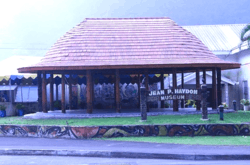

.svg.png)
